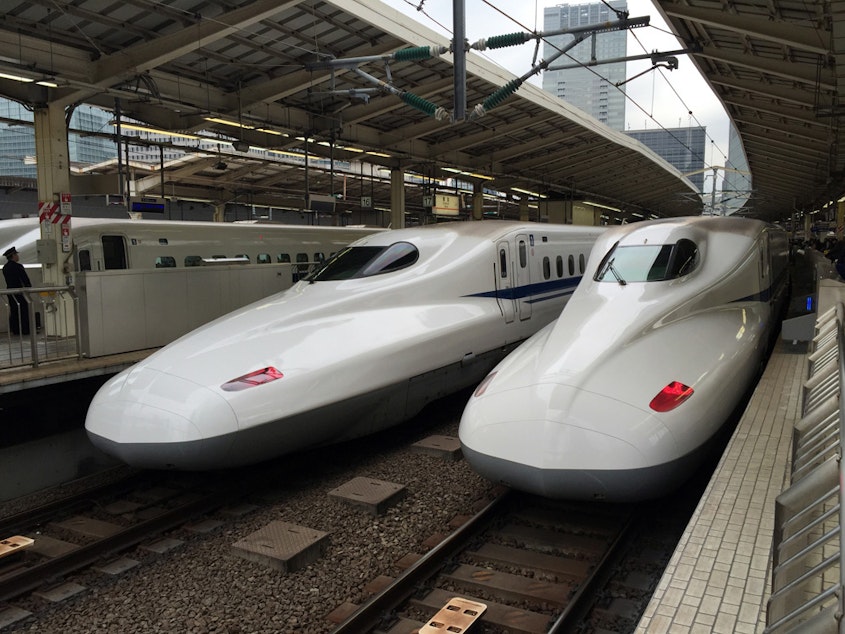Cascadia bullet train on track for big bucks to get rolling, but big uncertainty remains

For more than five years, Washington state, Oregon and British Columbia have collaborated on studies of a possible Cascadia bullet train to run between Portland, Seattle and Vancouver, Canada. This winter, the Washington Legislature approved money for yet more studies. But state lawmakers also set aside a much bigger sum to attract federal support that could advance the bullet train dream toward being shovel-ready.
Project supporters envision a train with a top speed of at least 250 mph operating on a dedicated track. That could whisk travelers from Vancouver, B.C., to Seattle in one hour and from Seattle to Portland in another hour, in a climate-friendly manner to boot.
The current top speed of Amtrak trains in the Pacific Northwest is 79 mph. Those passenger trains are routinely delayed by congestion on a mainline shared with freight trains.
"Look at Spain. Look at France. Look at Germany. Look at Italy. Look at China, look at Japan,” said Washington Senate Transportation Committee Chair Marko Liias (D-Mukilteo) in a rat-a-tat cadence. “We're not the first ones to this game. Candidly, we're probably in the tail end. We're sort of getting in last into this space following the lead of many of our global competitors."
Democrats in control of the Washington Legislature tucked $150 million into a recently approved state transportation infrastructure package for what they are branding as “ultra-high speed rail.” Liias said the goal is to attract four times as much in matching dollars from the new federal infrastructure bill. If the federal Department of Transportation gets onboard, that could total up to $750 million to get a Cascadia bullet train off the drawing board.
Sponsored
In an interview, Liias said such a sum of money would allow the states and their consultants to "do community outreach, environmental work, designing and planning to get a significant proposal in front of decision makers in British Columbia, Oregon and Washington and our federal funding partners."
He added that the partners still need to figure out how to pay the high cost of right-of-way acquisition and actual construction. A feasibility study completed in 2017 pegged the cost of building a Vancouver-Seattle-Portland bullet train at between $24 billion to $42 billion depending on how much tunneling is involved.
Skeptics are already raising cries of "boondoggle" together with warnings to heed what is happening in California. The underway Los Angeles to Bay Area high-speed rail project is suffering from ballooning costs, slow construction and endless lawsuits.
“The $150 million is both a large sum of money and also surprising,” said transportation policy analyst Mariya Frost of the conservative-leaning Washington Policy Center. “For me, it’s surprising because the state has far bigger and more meaningful priorities in maintaining existing roads and building out the projects they promised in (2015).”
Even within the community of rail advocates, there are mixed opinions about what track to take in Cascadia. Bill Moyer of Vashon Island, who co-authored the book Solutionary Rail, said he fears lawmakers have been seduced by a bright, shiny object, meaning the bullet train.
Sponsored
"It's obscene,” Moyer said in an interview. “It really takes all the oxygen out of the room for offering common sense solutions in a timely manner."
Moyer argued taxpayers and travelers could get better bang for the buck and environmental goals would be achieved quicker by prioritizing improvements to the existing Amtrak service.
"If you spent $10 billion on the north-south corridor and another couple billion doing the electrification of railyards and rail lines, we'd start to have a very functional system that was very competitive for passengers and freight in a much shorter timeline, in a way to actually make a difference for the climate," Moyer said.
Power players like Microsoft, Amazon, Costco and governors past and present are vocally backing the Cascadia bullet train proposal and sending thank-yous to the Legislature.
"Linking Vancouver, B.C., Seattle and Portland will promote additional collaboration and innovation, expand job opportunities and enhance the region's position on the world stage," Microsoft’s Irene Plenefisch told lawmakers during a committee hearing last month. "It's a transformative project that will be a game changer for generations to come."
Sponsored
Senator Liias said an ideal outcome would be to win federal funding for both a future bullet train and upgrading existing Amtrak Cascades service.
Washington state lawmakers put strings on their bullet train down payment. The $150 million in state money can't be spent unless it unlocks a federal match. It will probably be another year before the Federal Railroad Administration divvies up the billions in competitive grants for new passenger rail projects across the nation.
In the meantime, the Washington Legislature’s latest transportation budget included a separate $4 million in state taxpayer money to continue planning and outreach on ultra-high-speed rail contingent on Oregon and British Columbia making "meaningful financial contributions.”
Copyright 2022 Northwest News Network

